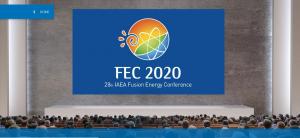The virtual experience
The international fusion community charts the progress of its craft.
Sixty years after the start of the conference series, and even in the context of high-speed internet that places the world at each scientist's fingertips, the FEC remains the most important gauge for measuring the progress made towards the taming of the atom.
Only this time, the boundary conditions had changed. A virus had first forced the IAEA and the local hosts, the ITER Organization and the French Alternative Energies and Atomic Energy Commission (CEA), to postpone the meeting originally planned in Nice in September 2020. When it became clear that a live meeting would not be feasible, the decision was made to go virtual.
But would that format work for the FEC? A conference whose uniqueness and importance is not only grounded in the official presentations but also in the informal talks in the corridors—the very feature, in fact, that had helped to overcome the political divide between the East and the West during the Cold War and that had ultimately laid the basis for today's world-spanning cooperation in fusion research.
The answer, in short, is yes—it worked. And it worked so well that the 28th FEC broke all records. During the course of the week, 4,200 registered attendees connected to the platform set up by service provider AOS, two-thirds of whom were observers. The virtual experience had made it possible to open the FEC to a much wider scientific audience, and to students, media and industry. Over six full days, participants followed an impressive line-up of 134 talks and 544 poster presentations, all pre-recorded, charting the most recent progress made.
"Over the last years, we have seen fusion advancing quicker than ever before," stated IAEA Director General Rafael Mariano Grossi in his opening speech. While publicly funded fusion experiments such as ITER, JT-60SA, JET and Wendelstein-7X continued to progress, "research in fusion science and technology is also being conducted more and more in the private sector." The increase in public and privately funded research and development¹, including emerging examples of public-private partnerships, "demonstrate growing trust in fusion as a promising option to provide a sustainable, worldwide supply of energy for centuries to come," concluded Grossi.
The focus of attention at this 28th FEC conference, by nature, was on the ITER Project. In addition to the latest progress report on construction and assembly presented by ITER Director-General Bernard Bigot (see related video, here), significant progress has also been made in addressing open R&D issues for the implementation of the ITER Research Plan, according to ITER Science Division Head Alberto Loarte. "Of special importance are the advances in disruption mitigation with shattered pellet injection, ELM (edge localized mode) suppression with 3D magnetic fields, tungsten plasma-facing components under stationary and transient loads, enhanced confinement plasmas for long pulse Q=5 ITER scenarios, and high performance H-mode plasmas with neon seeding."
"We observed a lot of efforts devoted to these topics in many machines around the world," added Sehila M. Gonzalez de Vicente from the IAEA Physics Section. "This is directly connected with the objective of being able to operate in long pulse and finally in steady state." Gonzalez de Vicente also welcomed the growing involvement of the private fusion community and the diversity of approaches presented at FEC. "Spherical tokamaks are becoming a relevant community in fusion, with the Japanese ST research program, NSTX-U in the United States, Globus-M2 in Russia, and ST40 in the UK (built and run by a private company)."
The highlight for Elisabeth Surrey, Chairwoman of the 28th Fusion Energy Conference, was "the progress made on ITER construction since the last FEC and how many lessons we can learn from ITER, JT-60SA and WEST as we start to consider designing fusion demonstration power plants." It was also gratifying to see "a greater involvement of industry in fusion and an awareness in the community of the need for representative-scale manufacturing, testing and qualification," Surrey said. "Collaboration between nations, academia and industry will be essential to realizing fusion power and this FEC has shown that we are now achieving this. I hope it grows and strengthens in the future."
Two new machines were presented at the conference. HL-2M (Chengdu, China) achieved its first plasma in 2020, while and JT-60SA (Naka, Japan) is now in the integrated commissioning phase. Experimental results for both machines are expected at FEC 2023, scheduled to take place in London.
At the start of the conference, representatives of the European Commission, France (as host country), and the United States had confirmed their commitment to the development of fusion energy.
European Union Commissioner for Energy, Kadri Simson, highlighted the Union's 2050 climate-neutrality ambitions as a means to confront climate change, and described the bloc's commitment to ITER as a scientific investment that could support climate goals.
François Jacq, CEA Chairman and French High Representative for the ITER Project, echoed messages on climate action and fusion's potential role in post-2050 energy mix, describing how the CEA is involved in both magnetic confinement and inertial fusion research and saluting the progress being made at ITER despite COVID-19.
Representing the United States, Congresswoman Eddie Bernice Johnson said fusion warrants far greater support than what has been provided to date, arguing that a breakthrough in fusion research would be a major step in enabling a clean energy future and that "the policy decisions and research investments we make now could well enable those key advances to come much sooner."
Plenty of work for scientists and researchers until the FEC meets again.
¹Consult the IAEA's Fusion Device Information System (FusDIS) for a complete database of public and privately funded fusion devices in the world.


